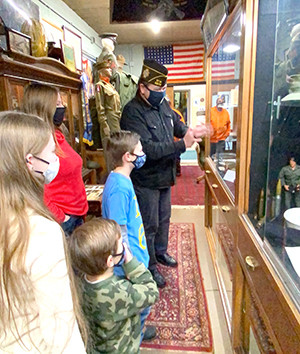
Chicagoland Combined Veterans Museum president, Lorenzo Fiorentino, conducts a tour of the museum for the River Forest Cub Scout Den and adults.
Through events that honour service members and educate the community, the Chicagoland Combined Veterans Museum, Library and Honor Roll is bridging the gap between the military and civilians.
Located in River Grove, a Chicago, Illinois suburb, the museum houses military memorabilia, much of it donated by local families.
Retired Army Maj. Lorenzo Fiorentino, the museum’s founder, says he enjoys seeing both youth and adults view some of America’s history.
|
Image

|
|
“A lot of people who have walked through there have said it’s so important to capture all of this first-hand information; all of these artifacts,” Lorenzo says.
When scout troops visit, half of them come inside the museum and half watch a presentation that includes a screening of Sergeant Stubby, an animated film about a military dog who aided American troops during World War I.
Lorenzo says kids’ favourite artifacts include a camel bone, GI Joe toys representing different time periods, and “the dolls, carvings, cars and trucks I sent my own kids when I was in Afghanistan.”
Seeing the Honor Roll Wall can be emotional for adults.
“Some of the residents and people we’ve had come through there actually knew some of these individuals, as I did, and they were killed in action,” Lorenzo says. “It’s very personal.”
Then, “they see the pictures of those of us who did make it home who are also on the Honour Wall,” Lorenzo says. “It shows the brighter — the more light-hearted — side of coming home and our service while we’re out there.”
Lorenzo says both veterans and civilians are welcome at the museum.
“We all have different roles in life to play,” he says. “In the military we had a basic rule that for every soldier who was fighting in a war, it took six of them in some form or condition or shape to be supporting that soldier.”
Once, Lorenzo says he greeted a woman and her granddaughter who were visiting the museum. The woman told Lorenzo that she had immigrated to America.
“She looked at her granddaughter and says ‘this is important because these are the people who have made our country what it is,’” he says.
People can learn about the military through the words of area service members. “We have actual letters — first-hand information — of what it was like,” Lorenzo says.
Because museum volunteers add new material, “you can go in there several times and see something that you might have missed or that might not have been there the last time,” he says.
|
Image

|
|
The museum’s mission continues beyond its walls.
For people unable to attend in person, “we’re recording little clips on some of these items in the museum and putting them on Facebook and on our YouTube channel,” Lorenzo says.
The museum, which is attached to an American Legion post, has led trainings with a local Veterans Administration hospital and is planning activities like a bocce league and foosball club.
This summer, the museum hosted a Medal of Honor recipient, and led a family-friendly reenactment in a nearby suburb.
Community members can also feel more connected to current service members and veterans through charitable activities like Fischer House and K9s for Veterans supply drives, Toys for Tots and Girl Scout cookie collections and blood drives.
Sometimes, Lorenzo and other museum supporters help celebrate a milestone in a local veteran’s life — connecting civilians to their neighbours who have served.
A drive-by 100th birthday party for a paratrooper who served in Normandy during World War II stands out to Lorenzo. “His kids could not stop telling us how we made his day,” Lorenzo says, adding that the veteran was “on cloud nine.”
Lorenzo emphasized the importance of building relationships with each person he meets, whatever their background — something he learned while deployed in Afghanistan.
While his unit helped rebuild Afghanistan’s infrastructure to improve living standards, Lorenzo says many Afghans he met were eager to learn English. He discussed the importance of interpreters, who were the link between the American military and Afghan communities.
As some Afghans learned English to talk with Lorenzo, he learned some Dari and Pashto — Afghanistan’s official languages.
“It was more important to me to be able to greet somebody in their native language having been that I came from 7,500 miles away,” Lorenzo says.





